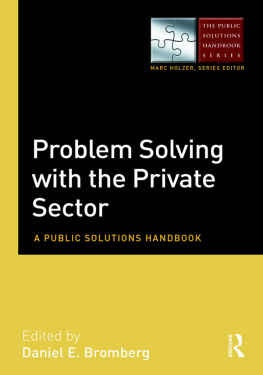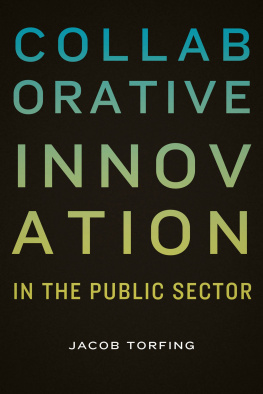Problem Solving with the Private Sector
An essential work comprising an objective and comprehensive analysis of modern public sector management instruments to lead to effective and efficient service delivery.
Christopher H. Bovis, University of Hull, UK
Problem Solving with the Private Sector presents advice and solutions for fruitful governmentbusiness alliances from the perspective of everyday public management. With a focus on job training, economic development, regulation, and finance and innovation, each chapter discusses a traditional tool of government, presented in a practical and applied manner, as well as the implementation of the tools with clear examples. Content-rich case studies on a wide range of policy issues, including regulatory policy, natural resources, manufacturing, financial services, and health care highlight opportunities for government and business to collaborate to pursue the public good.
This book offers current and future public managers possible solutions to complex problems for effective governmentbusiness alliances in a range of settings. It is essential reading for all those studying public management, public administration, and public policy.
Daniel E. Bromberg is Assistant Professor of Public Administration and the MPA Director at the University of New Hampshire, USA.
MUNICIPAL SHARED SERVICES
A Public Solutions Handbook
Alexander C. Henderson, Editor
E-GOVERNMENT AND WEBSITES
A Public Solutions Handbook
Aroon Manoharan, Editor
MANAGING THE NEXT GENERATION OF PUBLIC WORKERS
A Public Solutions Handbook
Madinah F. Hamidullah
PARTNERSHIP GOVERNANCE IN PUBLIC MANAGEMENT
A Public Solutions Handbook
Seth A. Grossman and Marc Holzer
INNOVATIONS IN THE PUBLIC AND NONPROFIT SECTORS
A Public Solutions Handbook
Patria de Lancer Julnes and Ed Gibson, Editors
GOVERNMENT CONTRACTING
A Public Solutions Handbook
Robert A. Shick, Editor
PROBLEM SOLVING WITH THE PRIVATE SECTOR
A Public Solutions Handbook
Daniel E. Bromberg, Editor
First published 2016
by Routledge
711 Third Avenue, New York, NY 10017
and by Routledge
2 Park Square, Milton Park, Abingdon, Oxon OX14 4RN
Routledge is an imprint of the Taylor & Francis Group, an informa business
2016 Taylor & Francis
The right of the editor to be identified as the author of the editorial material, and of the authors for their individual chapters, has been asserted in accordance with sections 77 and 78 of the Copyright, Designs and Patents Act 1988.
All rights reserved. No part of this book may be reprinted or reproduced or utilized in any form or by any electronic, mechanical, or other means, now known or hereafter invented, including photocopying and recording, or in any information storage or retrieval system, without permission in writing from the publishers.
Trademark notice: Product or corporate names may be trademarks or registered trademarks, and are used only for identification and explanation without intent to infringe.
Library of Congress Cataloging-in-Publication Data
Names: Bromberg, Daniel E., editor.
Title: Problem solving with the private sector : a public solutions handbook / edited
by Daniel E. Bromberg.
Description: First Edition. | New York : Routledge, 2016. | Series: The public
solution handbook series ; 7 | Includes bibliographical references and index.
Identifiers: LCCN 2015041314 | ISBN 9781138920798 (hardback : alk. paper) |
ISBN 9780765644060 (pbk. : alk. paper) | ISBN 9781315686820 (ebook)
Subjects: LCSH: Public-private sector cooperationUnited States.
Classification: LCC HD3872.U6 P76 2016 | DDC 658.4/03dc23
LC record available at http://lccn.loc.gov/2015041314
ISBN: 978-1-138-92079-8 (hbk)
ISBN: 978-0-7656-4406-0 (pbk)
ISBN: 978-1-315-68682-0 (ebk)
Typeset in Times
by Apex CoVantage, LLC
Contents
, Marc Holzer
Lauren Bock Mullins, Alexander C. Henderson, and Linda L. Vila
Brian Robert Calfano, Joumana Silyan-Saba, and Sheldon Cruz
Ian C. Graig
Jian Cui
Katharine A. Owens
Jonathan Q. Morgan
Carrie Blanchard Bush and Karen Jumonville
Joshua Franzel and Ryan Gregory
Quintus Jett and Arturo E. Osorio
Daniel E. Bromberg and Jonathan B. Justice
I am proud to announce the sixth volume in the Public Solutions Handbook series: Problem Solving with the Private Sector , edited by Daniel E. Bromberg. For centuries, governments and private businesses have been balancing the needs of societies. Some argue that where markets fail, governments can succeed, and in situations where governments fail, markets may offer compelling solutions. It seems we are well beyond the perspective that the public and private sectors are separated by some illusory wall in which functions of one can be isolated from the other. Rather, we frequently view government and business as mutually dependent when it comes to dealing with societys most complex problems. Certainly, we recognize that government and business play different roles in these solutions; nonetheless, a collaborative effort is often the most productive.
This book makes no attempt to argue the proper role of government and or business. Instead, the book provides a series of chapters offering possible solutions to complex problems. While many of the cases highlighted in this volume provide successful examples, we caution readers to thoughtfully pursue these collaborative efforts with their eyes wide open.
This volume is divided into four sections: Job Training, Regulation, Economic Development, and Finance and Innovation. Each section offers chapters with specific case studies to highlight opportunities.
In Lauren Bock Mullins, Alexander C. Henderson, and Linda L. Vila focus on publicprivate partnerships supporting workforce development in public education. The chapter provides a broad overview of these relationships and explores partnerships as tools for retaining an existing workforce, connecting unique or focused private-sector needs with specifically tailored programs in public educational institutions, and providing early access to educational opportunities for children. The key takeaways offer thoughts about scalability, addressing specific needs of the population and how such partnerships might offer solutions to complex problems.
In Brian Robert Calfano, Joumana Silyan-Saba, and Sheldon Cruz provide a very specific example of a publicprivate collaborative effort taking place in the City of Los Angeles. The chapter focuses on the collaboration between the City of Los Angeles Human Relations Commission, the Youth Ambassadors Program, and Googles Los Angeles office. The collaborative effort seeks to engage high school students on a number of fronts, including an introduction to government, a historical perspective of the city, civic engagement, human relations, social justice and organization, and professional and personal development. The broad goals of the program create opportunities for both government and business to engage with constituents and to create better relations with youth in the community.
In Ian C. Graig describes a collaborative effort in the rulemaking process concerning the automotive industry. Specifically, the chapter examines the rulemaking process for automotive carbon emissions. Ultimately, Graig concludes that early collaboration is essential to avoid some of the typical pitfalls that government, industry, and citizen groups frequently experience in the regulatory context. The goal of these collaborative efforts should be to find solutions that work for all parties involved, increasing the likelihood of successful efforts.











